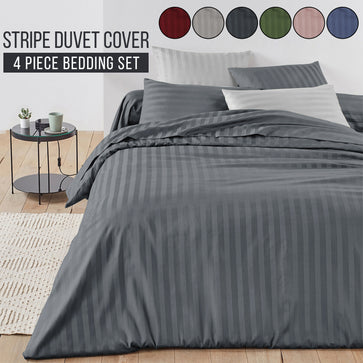How To Put On A Duvet Cover - 5 Quick Methods








Method 1: The Inside-Out Roll
The Inside-Out Roll is a classic technique that involves turning the duvet cover inside out and rolling it onto the duvet. Here's how:

- Turn the duvet cover inside out.
- Lay the duvet on top of the cover, matching the corners.
- Roll the duvet and cover together, starting from the closed end.
- Once rolled, unroll the cover over the duvet, aligning the corners as you go.
This method ensures a snug fit and minimises the risk of the duvet slipping inside the cover.
Method 2: The Burrito Roll
The Burrito Roll method might be your favourite if you love a good wrap. This technique involves rolling the duvet and cover together like a burrito, creating a seamless and hassle-free application:
- Lay the duvet cover flat on the bed, inside out.
- Place the duvet on top, matching the corners.
- Starting from the closed end, roll both the duvet and cover together.
- Once moved, flip the duvet cover's open end over the entire roll.
- Unroll the duvet and cover, adjusting as needed.
The Burrito Roll method ensures an even distribution of the duvet inside the cover, eliminating lumps and bumps.
Method 3: The Pocket Flip
The Pocket Flip method is perfect for those who want a straightforward approach with minimal fuss. Follow these steps:
15% OFF
GET FLAT 15% OFF ON YOUR FIRST PURCHASE

- Turn the duvet cover inside out.
- Locate the corners of the plain duvet cover and grasp them with your hands.
- With the duvet cover still inside out, reach inside and grab the corners of the duvet.
- Flip the duvet cover right side out, bringing the duvet with it.
This method is quick and efficient, ensuring a smooth and even spread of the duvet within the cover.
Method 4: The Shake and Slide
For a method that combines fun and functionality, try the Shake and Slide. This technique is ideal for more oversized duvets:

- Lay the duvet cover flat on the bed, with the open end at the top.
- Hold the duvet by its corners and shake it out to ensure an even distribution.
- Place the duvet on top of the cover, aligning the corners.
- Slide the duvet down to the closed end of the cover, allowing gravity to assist in the process.
The Shake and Slide method is quick and works well for those who prefer a less hands-on approach.
You may also like our Bouquet Printed Duvet Cover Set in Grey.
Method 5: The Clip and Climb
If you want to secure your duvet in place and prevent it from shifting inside the cover, the clip-and-climb method is for you:
- Turn the duvet cover inside out.
- Attach duvet clips or safety pins to each corner of the duvet.
- Match the corners of the duvet cover with those of the duvet.
- Securely fasten the clips or pins to the duvet cover, ensuring a tight connection.
- Flip the duvet cover right side out.
The Clip and Climb method is handy for those struggling with duvets slipping inside the cover at night.
On Oxford Homeware, you can get stripe duvet covers or 4-piece bedding sets.
Common Mistakes to Avoid
While these methods are effective, common mistakes can still occur. Here are some pitfalls to watch out for:
- Mismatched Corners: Please align the corners of the duvet and cover to ensure a balanced fit.
- Twisted Duvet: If the duvet twists inside the cover, it can lead to discomfort and an unkempt appearance.
- Incomplete Closure: Not fully closing the duvet cover can result in the duvet slipping out during use.
- Uneven Distribution: Improper rolling or shaking can lead to uneven duvet distribution inside the cover.
Tips on How to Rectify These Mistakes Quickly
- Mismatched Corners: Double-check that all corners are aligned before securing the duvet cover.
- Twisted Duvet: If you notice the duvet twisting, unzip the cover and straighten it before closing again.
- Incomplete Closure: Ensure the star design duvet cover is fully closed, and the fastening mechanism (buttons, snaps, or zipper) is secure.
- Uneven Distribution: Shake out the duvet and cover, ensuring it is evenly spread before securing it.
Conclusion
Putting on a duvet cover doesn't have to be a challenging chore. You can transform this task into a quick and enjoyable part of your bedding routine with the proper techniques and practice. Experiment with these five methods to discover which works best for you, and say goodbye to the frustration of a misaligned duvet cover. Happy bedding!
FAQs
What is a duvet cover, and why is it necessary?
A duvet cover is a protective fabric casing for your duvet or comforter. It is a removable and washable layer, adding style and functionality to your bedding. It protects the duvet from stains, wear, and tear while allowing easy cleaning.
How often should I wash my duvet cover?
You should wash your duvet cover every 1-2 weeks to maintain a clean and hygienic sleeping environment. However, this frequency can vary based on personal preference and lifestyle.
Can I use a duvet cover without a duvet?
Yes, you can! Duvet covers are versatile and can be used as a lightweight bedspread. They also offer an easy way to change the look of your bedding without investing in a new duvet.
Can I mix and match duvet covers with different bedding sets?
Certainly! Mixing and matching duvet covers with different sheets and pillowcases can create a unique and personalised look for your bed. Experiment with colours and patterns to suit your style.
How do I prevent my duvet from bunching up inside the cover?
To prevent bunching, consider securing the corners of your duvet inside the cover using clips or ties. This ensures an even distribution of the duvet within the cover, maintaining a smooth appearance.
Are duvet covers suitable for children and pets?
Yes, duvet covers are practical for families with children and pets. They provide an easily washable layer, protecting the duvet from spills, stains, and fur while allowing for a quick style update in children's rooms.
Can I iron my duvet cover?
Most duvet covers are made from materials that can be ironed at a moderate temperature. Check the care instructions on the label to ensure you don't damage the fabric. Ironing can help achieve a crisp and neat appearance.
What are the benefits of using a duvet cover?
Using a duvet cover enhances the lifespan of your duvet, protects it from dirt and damage, and allows for effortless style changes in your bedroom. It's a practical and stylish addition to any bedding ensemble.







